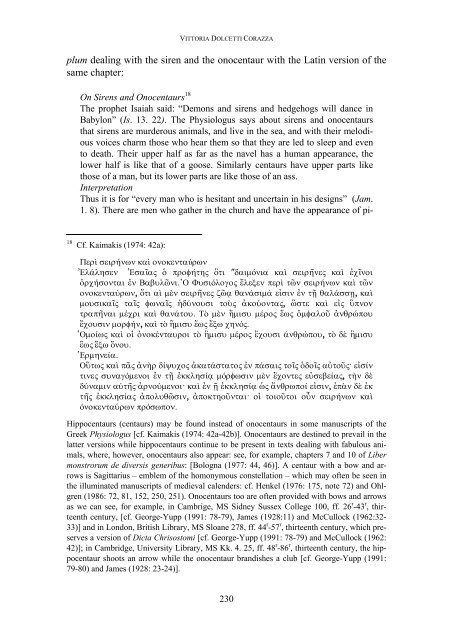Crossing paths in the Middle Ages: the Physiologus in Iceland - Lear
Crossing paths in the Middle Ages: the Physiologus in Iceland - Lear
Crossing paths in the Middle Ages: the Physiologus in Iceland - Lear
Create successful ePaper yourself
Turn your PDF publications into a flip-book with our unique Google optimized e-Paper software.
VITTORIA DOLCETTI CORAZZA<br />
plum deal<strong>in</strong>g with <strong>the</strong> siren and <strong>the</strong> onocentaur with <strong>the</strong> Lat<strong>in</strong> version of <strong>the</strong><br />
same chapter:<br />
On Sirens and Onocentaurs 18<br />
The prophet Isaiah said: “Demons and sirens and hedgehogs will dance <strong>in</strong><br />
Babylon” (Is. 13. 22). The <strong>Physiologus</strong> says about sirens and onocentaurs<br />
that sirens are murderous animals, and live <strong>in</strong> <strong>the</strong> sea, and with <strong>the</strong>ir melodious<br />
voices charm those who hear <strong>the</strong>m so that <strong>the</strong>y are led to sleep and even<br />
to death. Their upper half as far as <strong>the</strong> navel has a human appearance, <strong>the</strong><br />
lower half is like that of a goose. Similarly centaurs have upper parts like<br />
those of a man, but its lower parts are like those of an ass.<br />
Interpretation<br />
Thus it is for “every man who is hesitant and uncerta<strong>in</strong> <strong>in</strong> his designs” (Jam.<br />
1. 8). There are men who ga<strong>the</strong>r <strong>in</strong> <strong>the</strong> church and have <strong>the</strong> appearance of pi-<br />
18 Cf. Kaimakis (1974: 42a):<br />
Perì seirÉnwn kaì onokentaύrwn<br />
’Elálhsen ’Esaîaς % profÉthς ÷ti ″daimónia kaì seirÊneς kaì 2cînoi<br />
5rcÉsontai 2n BabulÔni. ‘O Fusiólogoς ðlexen perì tÔn seirÉnwn kaì tÔn<br />
onokentaúrwn, ÷ti aì mèn seirÊneς zÔ< qanásimá e4s<strong>in</strong> 2n tŸ qaláss>, kaì<br />
mousikaîς taîς fwnaîς #dúnousi toùς 1koúontaς, øste kaì e4ς Üpnon<br />
trapÊnai mécri kaì qanátou. Tò mèn ¼misu méroς Ðwς 5mfaloû 1nqrÓpou<br />
ðcous<strong>in</strong> morfÉn, kaì tò ¼misu Ðwς ðxw chnóς.<br />
‘Omoíwς kaì o$ 5nokéntauroi tò ¼misu méroς ðcousi ánqrÓpou, tò dè ¼misu<br />
Ðwς ðxw önou.<br />
‘Ermhneía.<br />
OÜtwς kaì pâς !nÈr díyucoς !katástatoς 2n pásaiς toîς %doîς a7toûς: e4sín<br />
t<strong>in</strong>eς sunagómenoi 2n tŸ 2kklhsí< mórfws<strong>in</strong> mèn êconteς e7sebeíaς, tÈn dè<br />
dúnam<strong>in</strong> aútÊς !rnoúmenoi: kaì 2n Ÿ 2kklhsí< *ς çnqrwpoí e4s<strong>in</strong>, 2pàn dè 2k<br />
tÊς 2kklhsíaς !poluqÔs<strong>in</strong>, !pokthoûntai: o$ toioûtoi oÝn seirÉnwn kaì<br />
ónokentaúrwn próswpon.<br />
Hippocentaurs (centaurs) may be found <strong>in</strong>stead of onocentaurs <strong>in</strong> some manuscripts of <strong>the</strong><br />
Greek <strong>Physiologus</strong> [cf. Kaimakis (1974: 42a-42b)]. Onocentaurs are dest<strong>in</strong>ed to prevail <strong>in</strong> <strong>the</strong><br />
latter versions while hippocentaurs cont<strong>in</strong>ue to be present <strong>in</strong> texts deal<strong>in</strong>g with fabulous animals,<br />
where, however, onocentaurs also appear: see, for example, chapters 7 and 10 of Liber<br />
monstrorum de diversis generibus: [Bologna (1977: 44, 46)]. A centaur with a bow and arrows<br />
is Sagittarius – emblem of <strong>the</strong> homonymous constellation – which may often be seen <strong>in</strong><br />
<strong>the</strong> illum<strong>in</strong>ated manuscripts of medieval calenders: cf. Henkel (1976: 175, note 72) and Ohlgren<br />
(1986: 72, 81, 152, 250, 251). Onocentaurs too are often provided with bows and arrows<br />
as we can see, for example, <strong>in</strong> Cambrige, MS Sidney Sussex College 100, ff. 26 r -43 r , thirteenth<br />
century, [cf. George-Yupp (1991: 78-79), James (1928:11) and McCullock (1962:32-<br />
33)] and <strong>in</strong> London, British Library, MS Sloane 278, ff. 44 r -57 r , thirteenth century, which preserves<br />
a version of Dicta Chrisostomi [cf. George-Yupp (1991: 78-79) and McCullock (1962:<br />
42)]; <strong>in</strong> Cambridge, University Library, MS Kk. 4. 25, ff. 48 r -86 r , thirteenth century, <strong>the</strong> hippocentaur<br />
shoots an arrow while <strong>the</strong> onocentaur brandishes a club [cf. George-Yupp (1991:<br />
79-80) and James (1928: 23-24)].<br />
230

















